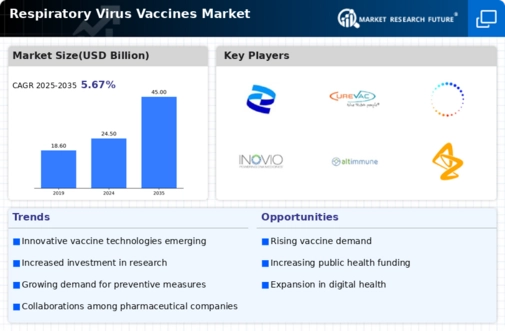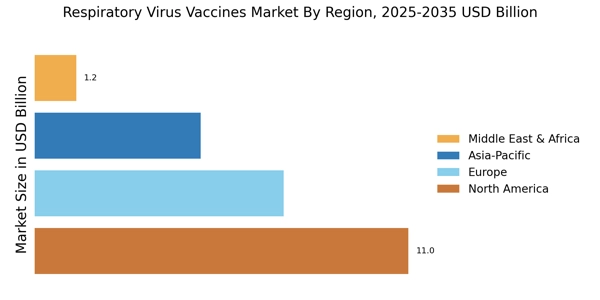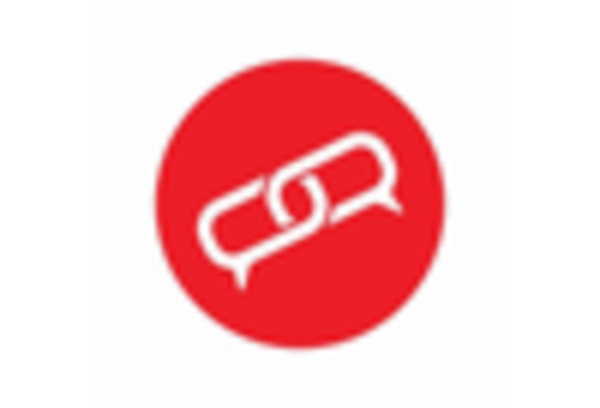Advancements in Vaccine Technology
Technological advancements in vaccine development are significantly influencing the Respiratory Virus Vaccines Market. Innovations such as mRNA technology and viral vector platforms have revolutionized vaccine efficacy and safety profiles. These advancements enable the rapid development of vaccines in response to emerging respiratory viruses, thereby enhancing public health preparedness. For instance, mRNA vaccines have demonstrated remarkable effectiveness in inducing robust immune responses, which is crucial for combating respiratory viruses. The ability to produce vaccines more efficiently and at scale is likely to attract investment and foster competition within the market. As a result, the ongoing evolution of vaccine technology is anticipated to drive growth and diversification in the Respiratory Virus Vaccines Market.
Government Initiatives and Funding
Government initiatives aimed at combating respiratory diseases are pivotal in shaping the Respiratory Virus Vaccines Market. Increased funding for vaccine research and development, alongside public health campaigns promoting vaccination, are essential components of these initiatives. Many governments are prioritizing respiratory virus vaccines as part of their health strategies, recognizing the economic and social implications of respiratory infections. For example, substantial investments in vaccine infrastructure and distribution networks are being made to ensure accessibility and affordability. This proactive approach not only enhances public health outcomes but also stimulates market growth. The commitment of governments to support vaccine development and distribution is likely to create a favorable environment for the Respiratory Virus Vaccines Market.
Growing Awareness of Preventive Healthcare
The rising awareness of preventive healthcare is a significant driver of the Respiratory Virus Vaccines Market. As individuals become more informed about the benefits of vaccination, there is a corresponding increase in demand for respiratory virus vaccines. Public health campaigns and educational initiatives are playing a crucial role in promoting the importance of vaccination as a preventive measure against respiratory infections. This shift towards preventive healthcare is supported by data indicating that vaccination can substantially reduce the incidence of respiratory diseases. Consequently, healthcare providers are increasingly advocating for vaccination as a key strategy in disease prevention. The growing emphasis on preventive healthcare is expected to bolster the Respiratory Virus Vaccines Market, as more individuals seek vaccination to protect themselves and their communities.
Rising Incidence of Respiratory Infections
The increasing prevalence of respiratory infections, such as influenza and respiratory syncytial virus, is a primary driver of the Respiratory Virus Vaccines Market. Data indicates that respiratory infections account for a substantial portion of global morbidity and mortality, particularly among vulnerable populations such as the elderly and young children. This trend underscores the urgent need for effective vaccination strategies. As healthcare systems grapple with the burden of these infections, the demand for vaccines is likely to escalate. The World Health Organization has reported that respiratory infections are among the leading causes of death worldwide, further emphasizing the critical role of vaccines in mitigating these health challenges. Consequently, the rising incidence of respiratory infections is expected to propel growth in the Respiratory Virus Vaccines Market.
Collaborative Research and Development Efforts
Collaborative efforts in research and development are driving innovation within the Respiratory Virus Vaccines Market. Partnerships between pharmaceutical companies, academic institutions, and governmental organizations are fostering the sharing of knowledge and resources, which is essential for developing effective vaccines. These collaborations often lead to accelerated research timelines and enhanced vaccine formulations. For instance, joint ventures have been established to explore novel vaccine candidates and improve existing ones. The pooling of expertise and funding from various stakeholders is likely to result in breakthroughs that could significantly impact public health. As the landscape of respiratory virus vaccines evolves, these collaborative efforts are expected to play a crucial role in advancing the Respiratory Virus Vaccines Market.


















Leave a Comment